Utah is home to many fascinating plants, including some that are very dangerous. The dangerous plants we’re talking about are poisonous, like baneberry and false hellebore. So before you head out for a nature hike, beware of the dangerous plants that grow in Utah, including the seven plants featured below. Because unfortunately, touching or ingesting any parts of these plants could bring on severe symptoms that might require medical care.
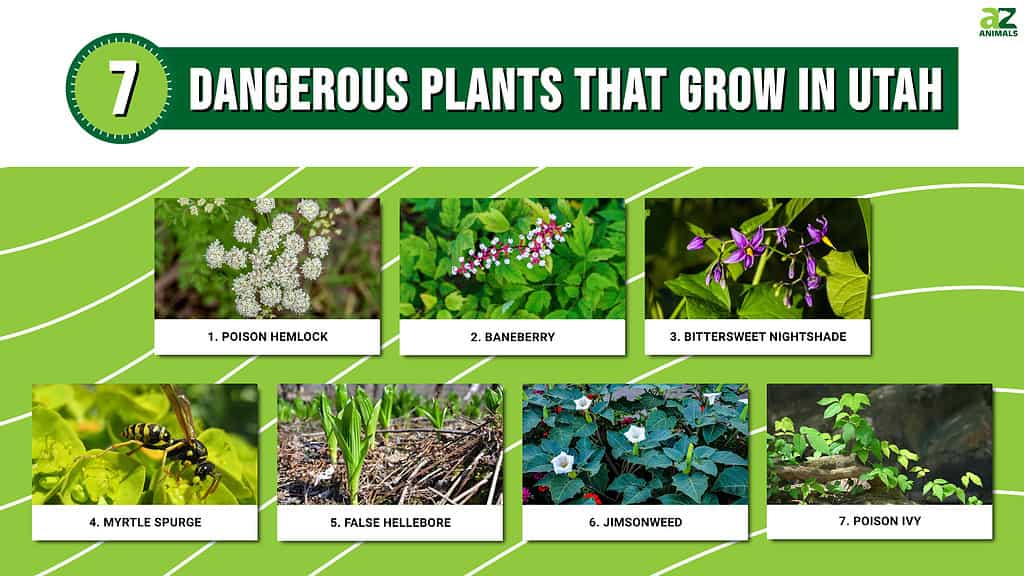
If you’re already experiencing symptoms of plant poisoning, keep reading for some quick ways to get support.

Having closed-toe shoes and a first aid kit are important precautions to take around dangerous plants.
©eurobanks/Shutterstock.com
How to Get Support for Plant Poisoning
If you or a loved one are experiencing symptoms of plant poisoning, you can use the following resources for support:
- 911.gov: Call or text 911 for emergency medical care.
- Poison Control: Call 1-800-222-1222 for free, confidential support with poisoning symptoms.
- Centers for Disease Control and Prevention: Check out their website for information about symptoms and first aid for poisonous plants.
3 Easy Ways to Prevent Plant Poisoning
Poisoning from plants can cause mild-to-life-threatening symptoms. But you can help prevent these conditions with the three easy steps below:
- Don’t touch, disturb, or eat any plants unfamiliar to you, just in case they are poisonous.
- Wear protective clothing while spending time around wild Utah plants that are unfamiliar to you. Protective clothing could include gloves, long sleeves, long pants, and closed-toe shoes.
- Make sure you have access to a plant identification app or guidebook while enjoying time around wild plants. And read more articles like this one to learn about the poisonous plants that grow near you.
It’s also a sound idea to carry a first aid kit with bandages, wipes, degreasing soap, antiseptic cream, and over-the-counter painkillers like ibuprofen.
Are you familiar with the poisonous Utah plants listed below? Scroll on to see their descriptions and the possible symptoms they could cause humans, livestock, and pets.
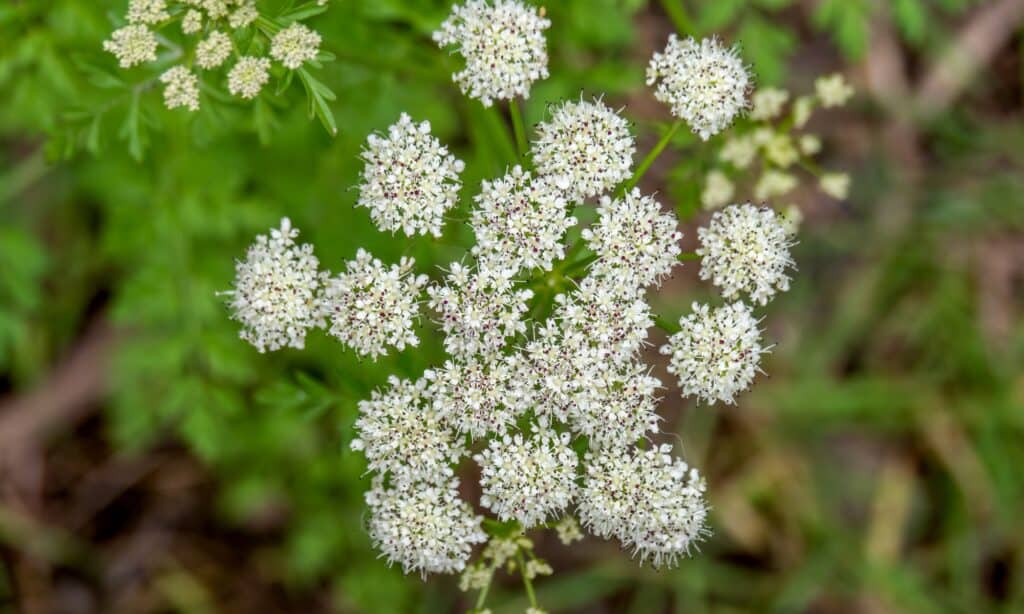
The poison hemlock is one of the most dangerous plants in Utah.
©iStock.com/Goldfinch4ever
1. Poison Hemlock
- Scientific Name: Conium maculatum
- Common Names: Poison hemlock, deadly hemlock, poison parsley, spotted hemlock, Nebraska hemlock, European hemlock, California hemlock
- Plant Description: Poison hemlock is a tall plant with an upright growing habit, fern-like green leaves, and spotted stems. It also produces tiny white flowers that grow in clusters shaped like upside-down umbrellas. Additionally, poison hemlock plants produce ridged green fruit that matures to brown.
- Mature Height: The poison hemlock plant grows 4–9 feet tall.
- Plant Habitat: Poison hemlock grows in wet soil fields, roadsides, and along marshes and streams.
- Toxic Parts of the Plant: All parts of this hemlock plant are poisonous, especially the roots and seeds. And the plant can remain highly toxic even after it dies.
- Symptoms of Plant Poisoning: Ingesting poison hemlock could result in trembling, a dry mouth, sweating, vomiting, weakness, an accelerated heartbeat, and dilated pupils. Severe hemlock symptoms could present as slowed bodily functions like decreased heart rate, lowered blood pressure, kidney failure, and muscle paralysis. Some cases lead to death. So get immediate emergency medical care if you think you are experiencing the symptoms of hemlock poisoning.
Poison hemlock is a highly toxic herbaceous plant that grows along the edges of fields, roadsides, and waterways in Utah. But, with its fern-like leaves and pretty clusters of tiny flowers, some inexperienced hikers and foragers might assume this plant isn’t a threat.
Take extreme caution when touching this poison hemlock, as its toxins could transfer from your skin to the mucus membranes of your nose, mouth, and eyes. And hemlock poisoning could occur through cuts and scrapes on your skin.
Toxins in Poison Hemlock
The poison hemlock plant contains poisonous alkaloids, including coniine, which inhibit the nervous system functions. These alkaloids are so toxic that poisoning from hemlock plants could result in death for humans and animals.
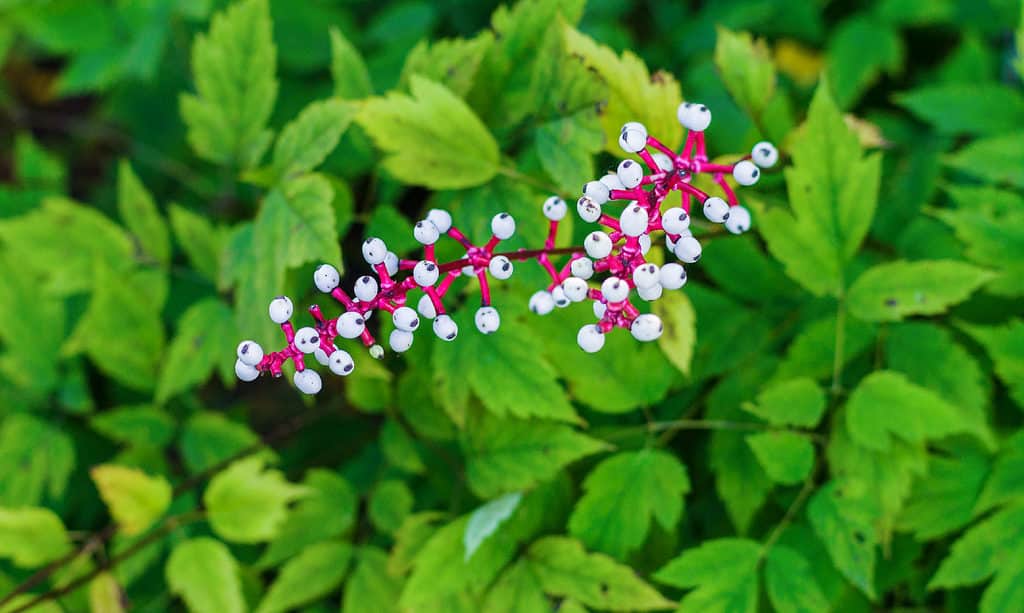
The berries on baneberry plants look like doll’s eyes, but they’re poisonous to humans and most animals.
©Alex Polo/Shutterstock.com
2. Baneberry
- Scientific Name: Actaea rubra for red baneberry and Actaea pachypoda for white baneberry
- Common Names: Baneberry, Western baneberry, red baneberry, white baneberry, cohosh, red cohosh, snakeberry, necklaceweed, doll’s eye baneberry
- Plant Description: Baneberry is a perennial branching herb that produces small clusters of white spring flowers and poisonous summer berries. This deciduous plant also has large, light green leaves that grow in three leaflets. The berries of this plant are white or red and have a dark purple dot in the middle, resembling a doll’s eye. This trait is why this plant has the common name doll’s eye baneberry.
- Mature Height: 3-4 feet
- Plant Habitat: Baneberry thrives in areas with moist soil, including forests and shaded woodlands. The Utah State University Extension says baneberry plants are found locally in mountain brush and tree communities like aspen and willow-birch at elevations between 4,500-10,000 feet.
- Toxic Parts of the Plant: All baneberry plant parts are poisonous if eaten, especially the roots and berries.
- Symptoms of Plant Poisoning: The common symptoms of baneberry poisoning include dizziness, diarrhea, nausea, vomiting, and abdominal pain. More severe cases could include delirium and circulatory failure, where body tissues can’t get enough blood.
One of the most dangerous plants in Utah is the baneberry, with its poisonous red or white berries. Birds like the wood thrush and American robin snack on these berries without harm, but humans and most other animals should never eat them. Unfortunately, the rest of the plant, including the roots, could also be highly toxic.
You’ll find baneberry plants growing in wetlands and areas with moist soil near trees, like forests with pine and spruce stands.
Toxins in Baneberry Plants
One of the toxic compounds in baneberry is ranunculin, commonly found in buttercup family plants. During digestion, ranunculin breaks down into a chemical called protoanemonin that causes burning and inflammation of the GI tract.
Baneberry contains a mix of multiple toxic compounds, including ranunculin and cardiogenic toxins, that make this plant highly poisonous. Though death from baneberry poisoning is rare, it could lead to circulatory failure.
The USDA Forest Service states that symptoms of baneberry poisoning could last for three hours and could be much worse for children than adults.
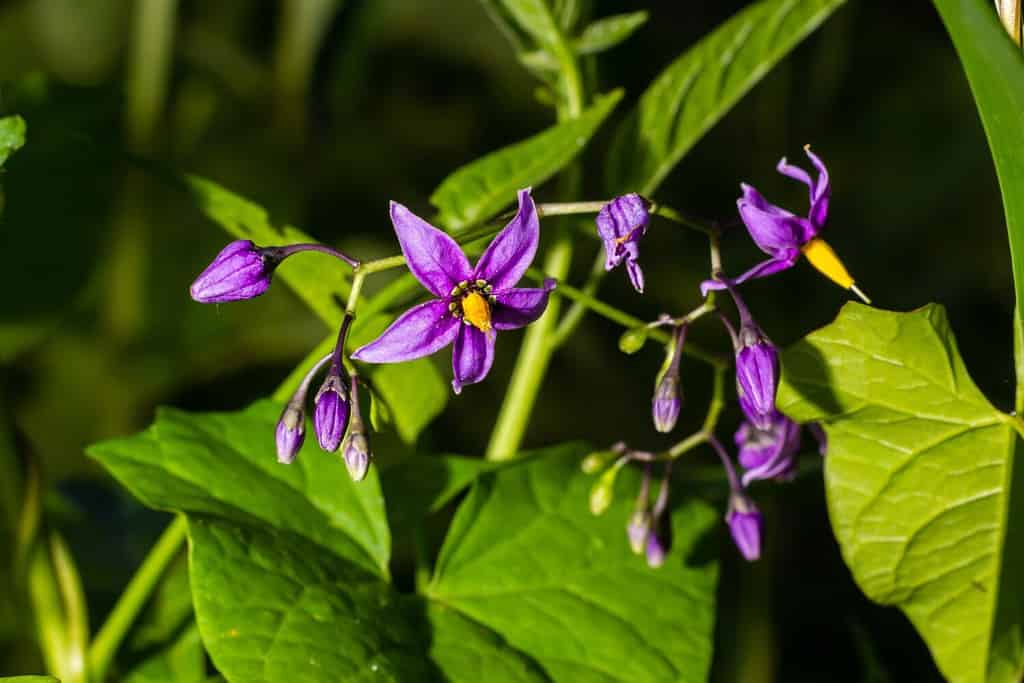
The poisonous climbing vine bittersweet nightshade is a plant that thrives near water or in wet soil.
©olko1975/Shutterstock.com
3. Bittersweet Nightshade
- Scientific Name: Solanum dulcamara
- Common Names: Bittersweet nightshade, climbing nightshade, European bittersweet, woody nightshade, blue bindweed, and felonwort
- Plant Description: Bittersweet nightshade is a perennial vine that produces violet star-shaped blooms with bright yellow center cones that house the stamens. This dangerous Utah plant also has green, lobed leaves and egg-shaped berries that mature from green to red.
- Mature Height: This climbing vine usually creeps an average of 8 feet high.
- Plant Habitat: Riparian zones (near bodies of water) and other areas with moist soil, like deciduous forests
- Toxic Parts of the Plant: All parts of the bittersweet nightshade plant are toxic, but the unripe berries and leaves are especially dangerous if eaten.
- Symptoms of Plant Poisoning: Eating any part of the bittersweet nightshade plant could lead to nausea, vomiting, diarrhea, and burning sensations in the throat. Severe cases could include dizziness, slowed breathing, convulsions, heart arrhythmia, and (rarely) death.
Sometimes mistaken for the deadly nightshade plant (Atropa belladonna), the bittersweet nightshade (S. dulcamara) is also poisonous. This climbing vine produces flowers between spring and fall, with its berries ripening from late summer through fall.
Bittersweet nightshade berries are highly poisonous when unripe, but don’t eat them at any stage of maturity. The green berries turn yellow, orange, and finally red by autumn.
Toxins in Bittersweet Nightshade
A prominent toxic compound in bittersweet nightshade is solanine, a glycoalkaloid that causes neurological and gastrointestinal symptoms of plant poisoning. Solanine is common in most nightshade plants, including green potatoes.
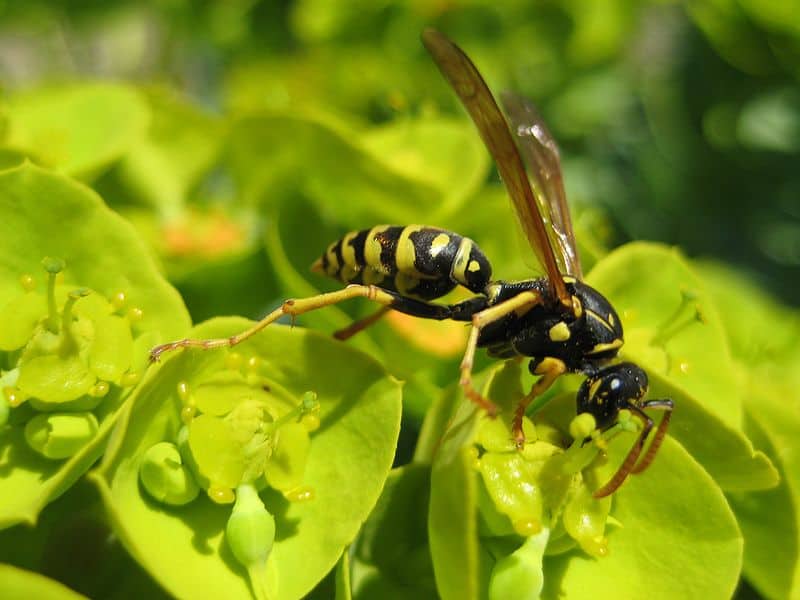
The myrtle spurge plant is a succulent that attracts pests and pollinators but is toxic to humans.
4. Myrtle Spurge
- Scientific Name: Euphorbia myrsinites
- Common Names: Myrtle spurge, creeping spurge, donkey tail spurge, and blue spurge
- Plant Description: This non-native succulent plant has a toxic milky sap and a unique growth habit. Its bluish-green leaves stack themselves into a spiraling column. At the top of these interesting leaf columns are the yellow star-shaped blooms that appear from spring to summer. Myrtle spurge also produces brown pods with a few seeds inside each. This plant’s seeds can remain viable for at least five years or more.
- Mature Height: Myrtle spurge plants grow between 4-6 inches tall.
- Plant Habitat: Disturbed areas, waste sites, hillsides, woodlands, and grasslands in especially desert and semi-arid climates
- Toxic Parts of the Plant: Avoid all parts of the myrtle spurge plant because its sap is poisonous.
- Symptoms of Plant Poisoning: Touching the myrtle spurge plant can cause skin irritations like itching, burning, redness, blisters, swelling, and rashes. Eating any part of the myrtle spurge plant could cause nausea, vomiting, and diarrhea. Getting myrtle spurge sap in your eyes could cause temporary or permanent blindness.
Myrtle spurge has the rare status of being both an award-winning plant and a noxious weed. The Natural History Museum of Utah explains that this once popular succulent is now a plant so invasive that sales of it are restricted across the state.
Unfortunately, myrtle spurge is also a dangerous plant. Touching myrtle spurge can cause painful rashes and blisters because of its toxic sap. In addition, eating any part of the plant could cause digestive symptoms like vomiting and diarrhea.
Despite its toxic sap and status as a noxious weed, pollinators still love myrtle spurge for its nectar.
Toxins in Myrtle Spurge
According to the Franklin County Noxious Weed Control Board in Pasco, WA, myrtle spurge sap toxins include resiniferatoxin. It’s a compound similar to capsaicin in chili peppers, which explains why myrtle spurge causes painful rashes and blisters on the skin.
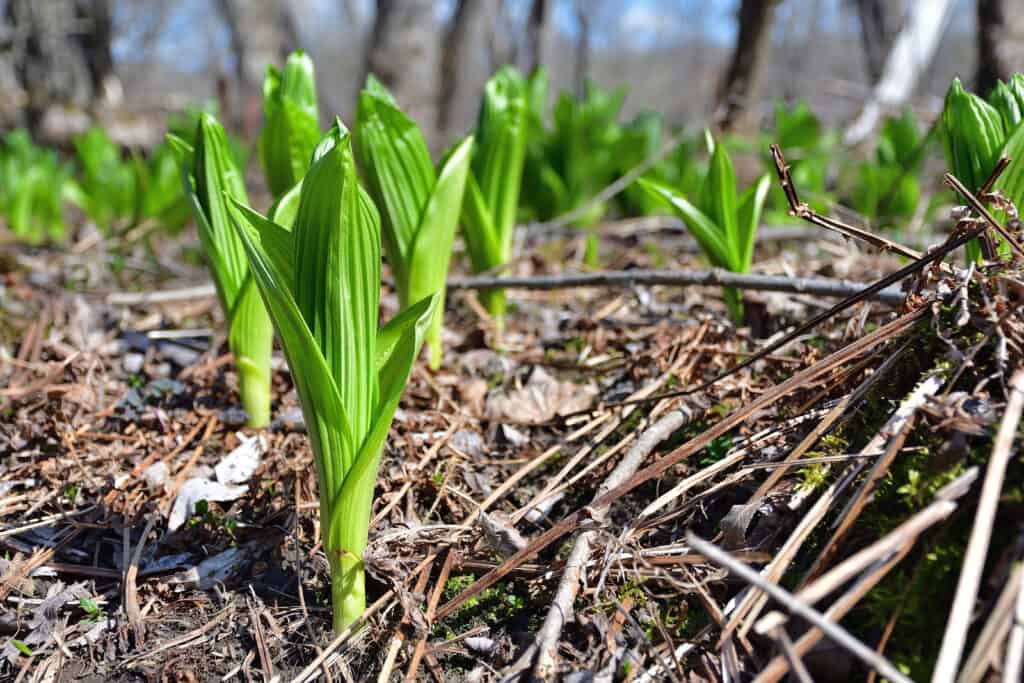
Unfortunately, the poisonous false hellebore plant is sometimes mistaken for edible wild ramps.
©Do Mi Nic/Shutterstock.com
5. False Hellebore
- Scientific Name: Veratrum californicum
- Common Name: False hellebore, wild corn, corn lily, cow cabbage, and veratrum
- Plant Description: The false hellebore produces large, pleated, oval leaves that grow in a basal rosette pattern from the base of the plant. The largest of its leaves can grow up to 12 inches long. False hellebore plants also grow a tall center stem topped with a large flower cluster (called an inflorescence) of tiny cream or white blooms that open in summer.
- Mature Height: False hellebore can grow up to 6 feet tall.
- Plant Habitat: Damp meadows and fields, hillsides, plus seepage and swamp areas
- Toxic Parts of the Plant: All parts of the false hellebore plant are toxic, with the highest level of toxins in its roots.
- Symptoms of Plant Poisoning: Ingestion of any part of the false hellebore plant can lead to nausea, vomiting, abdominal pain, headache, numbness, excessive salivation, weakness, shallow breathing, and an irregular heartbeat. Severe cases of false hellebore poisoning could result in convulsions, paralysis, coma, and even death. There have also been many reports of pregnant sheep ingesting false hellebore while grazing, which caused severe congenital disabilities in their offspring.
According to poisonous plant research in Logan, Utah, the false hellebore plant poses a serious health risk for livestock. In particular, sheep grazing on this plant can experience life-altering poisoning symptoms, including fetal harm during pregnancy. So it’s essential that pregnant sheep and other livestock like goats and cows avoid grazing near false hellebore plants.
This dangerous range plant, found in damp soils in fields and open meadows, holds most of its poisonous compounds in the roots. However, the entire plant is toxic to humans and animals.
Be aware that some plants, like wild leeks and ramps, look similar to false hellebore. For this reason, it’s important to consult with your local county extension office or a trustworthy plant identification resource before foraging for edible wild plants.
Toxins in False Hellebore
False hellebore and other plants in the Veratrum genus contain toxic components called steroidal alkaloids. These lipid-soluble compounds (also called Veratrum alkaloids) include the alkaloids cyclopamine, jervine, and veratridine. These and more alkaloids are toxic for humans and animals, causing mild to life-threatening symptoms that usually require immediate medical care.
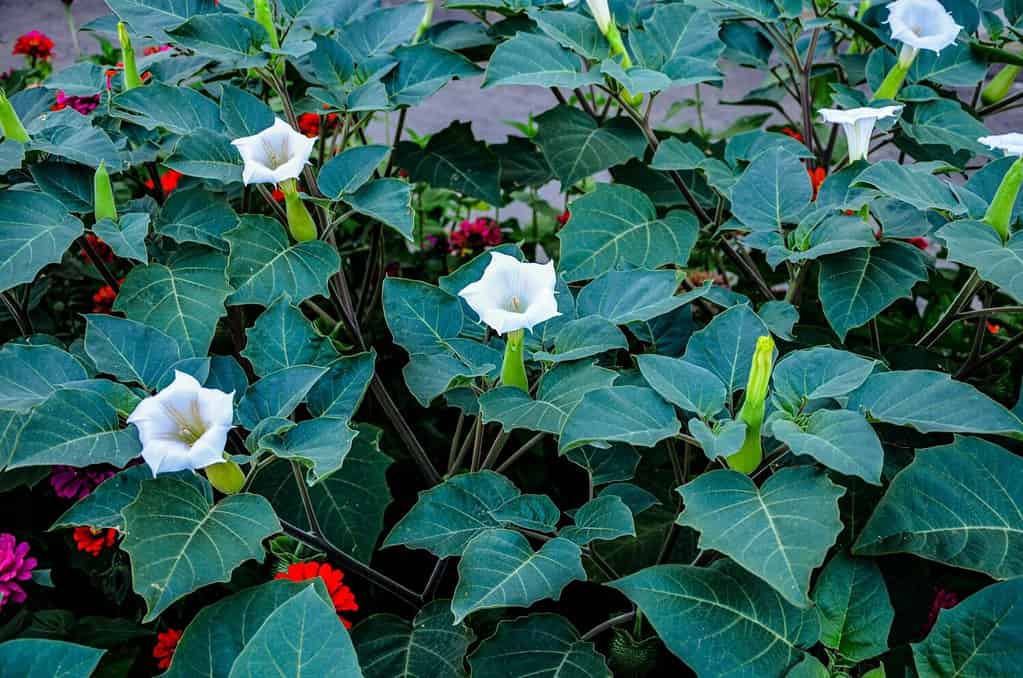
Flowers on jimsonweed plants are striking and smell sweet, but this dangerous Utah plant is highly toxic.
©weha/Shutterstock.com
6. Jimsonweed
- Scientific Name: Datura wrightii
- Common Name: Jimsonweed, Jimson weed, sacred datura, sacred thorn apple, thorn apple, angel trumpet
- Plant Description: Jimsonweed plants have large dark-green leaves and big white trumpet flowers that bloom between late spring and fall. This vigorous herbaceous plant’s foliage is bushy, toothed, and downy. Its flowers open at night, then close during the day. And its very noticeable seed pods are globe-shaped and covered with spines.
- Mature Height: Jimsonweed typically grows 4-5 feet tall.
- Plant Habitat: This plant grows best at elevations between 1,000 and 6,000 feet and is commonly found along ditches, roadsides, disturbed areas, and floodplains.
- Toxic Parts of the Plant: All parts of the jimsonweed plant are toxic to humans and animals.
- Symptoms of Plant Poisoning: Eating any part of a jimsonweed plant can cause a dry mouth and flushed skin, anxiety, dilated pupils, delirium, hallucinations, hypothermia, fever, panic attacks, profuse or decreased sweating, an irregular heartbeat, confusion, convulsions, and seizures.
The jimsonweed, or sacred datura, is a showy, tender perennial with dark, velvety leaves and striking white trumpet flowers. But jimsonweed is also one of the most dangerous plants that grow in Utah because its sap is highly toxic. Eating any part of this plant could severely hinder the function of neurological, respiratory, and other human body systems.
Made famous as the subject of some Georgia O’Keefe paintings, the jimsonweed plant is a beauty that provides lots of nectar to pollinators like hawk moths. And its flowers are sweetly fragrant, but the leaves give off an unpleasant odor when cut or crushed.
Toxins in Jimsonweed
Jimsonweed contains anticholinergic tropane alkaloids, which block the healthy function of acetylcholine (a neurotransmitter) in the peripheral and central nervous systems. These alkaloids are also hallucinogenic, resulting in symptoms like seeing illusions, anxiety, and panic attacks.
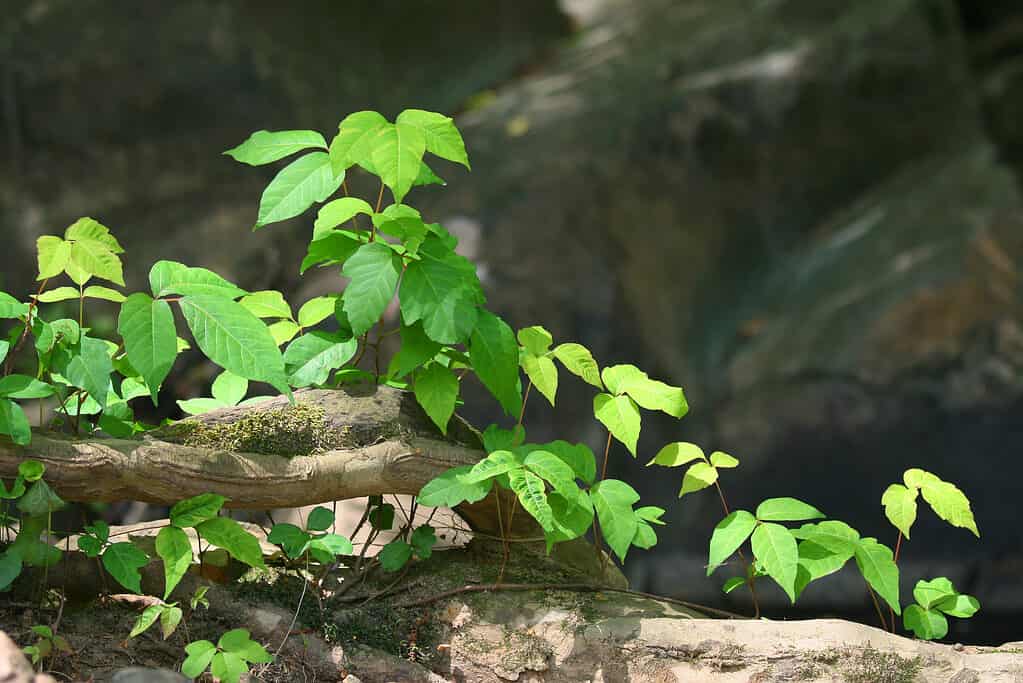
Touching poison ivy can result in rashes and blisters. Ingesting poison ivy could damage internal organs.
©iStock.com/email2ying
7. Poison Ivy
- Scientific Name: Toxicodendron radicans
- Common Name: Eastern poison ivy
- Plant Description: Poison ivy is famous for its 3-leaf clusters, small yellow-green flowers, and white berries. The shape and texture of poison ivy leaves can vary between dull or glossy and smooth or toothed. Plus, this dangerous Utah plant’s growth habit can be both climbing and shrub-like. Poison ivy produces its flowers in late spring through summer, and its leaves turn yellow-orange and brown in the fall.
- Mature Height: As a climbing plant, poison ivy can grow up a tree or other nearby structure to 75 feet high or more.
- Habitat: Trails, roadsides, forest edges and clearings, and other sunny woodlands
- Toxic Parts of the Plant: Avoid all parts of poison ivy plants.
- Symptoms of Plant Poisoning: Touching poison ivy can result in an itchy skin rash, redness, swelling, and blisters. Eating poison ivy could lead to stomach cramps, nausea, vomiting, and damage to the esophagus, kidneys, and other organs. Also, burning poison ivy plants can cause throat discomfort and difficulty breathing from inhaling the smoke.
Most people know about the dangerous plant growing in Utah called poison ivy. But did you know that the allergic reactions caused by touching poison ivy could lead to anaphylaxis? This hypersensitive condition can cause the throat to close, the tongue to swell, difficulty breathing, and loss of consciousness. And the symptoms of anaphylaxis could come on within minutes from poison ivy poisoning.
So wear protective clothing on your nature walks through wild and beautiful Utah vegetation, just in case you accidentally touch or brush against some poison ivy along the way.
Toxins in Poison Ivy
The poison ivy plant protects itself from predators by releasing a toxic oil when the leaves are touched or disturbed in any way. This poisonous oil is called urushiol, and it’s hard to remove from the skin unless you use anti-grease soap formulated to dissolve oily substances.
Urushiol contains a mix of allergenic compounds that are also found in poison oak and poison sumac plants.
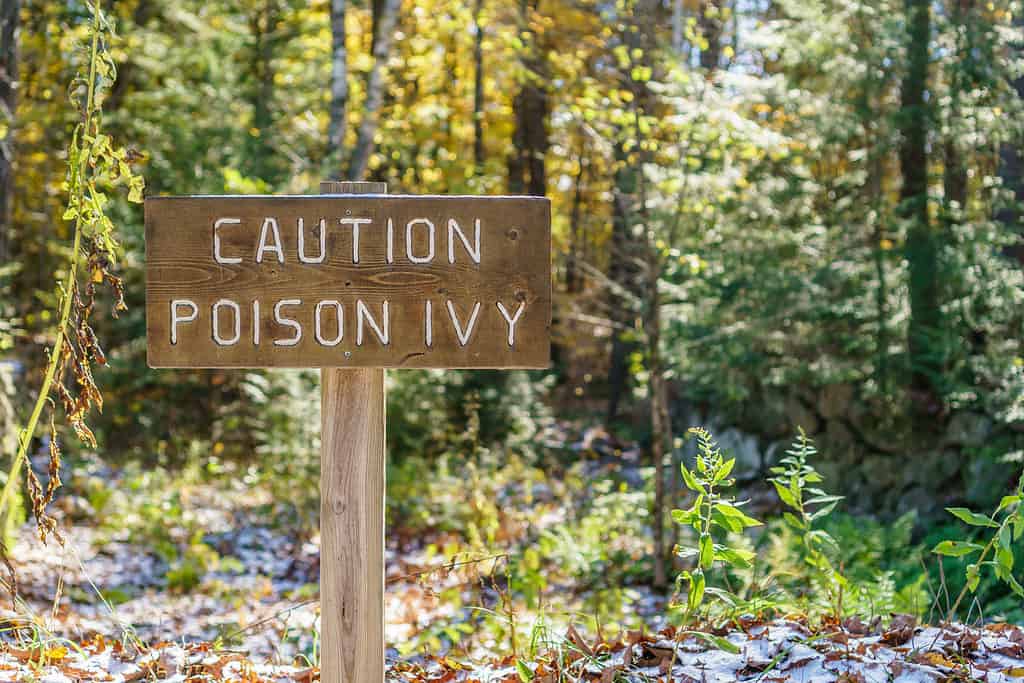
Poison ivy is only one of many dangerous plants that grow in Utah and other states across the US.
©iStock.com/HABesen
Dangerous plants that grow in Utah are poisonous to humans and animals.
Some of Utah’s native and invasive plants are full of toxins that could cause you and your animals harm. And poisoning from highly toxic plants like poison hemlock or bittersweet nightshade could be deadly. So beware of these and other dangerous plants that grow in Utah by learning about them and taking extra precautions when out among them.
Summary of 7 Dangerous Plants That Grow in Utah
| Number | Plant |
|---|---|
| 1 | Poison Hemlock |
| 2 | Baneberry |
| 3 | Bittersweet Nightshade |
| 4 | Myrtle Spurge |
| 5 | False Hellebore |
| 6 | Jimsonweed |
| 7 | Poison Ivy |
The photo featured at the top of this post is © iStock.com/emilio100
Thank you for reading! Have some feedback for us? Contact the AZ Animals editorial team.






